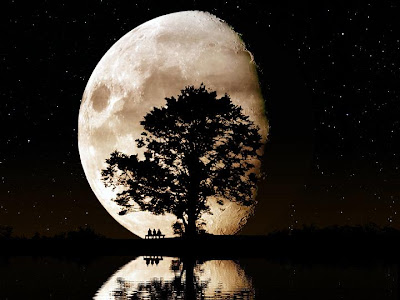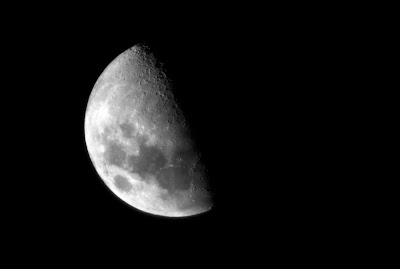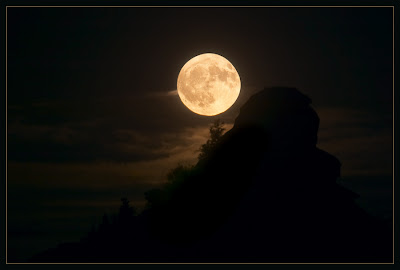
The moon is the nearest celestial body to Earth. Almost every night we can watch this thing, and maybe never tried mengabadikannya. Yet it is not as easy as shooting Month view. Here's a guide photographing the Moon with emphasis on portion and the speed of light.
In photography, the raw portion of the light brightness BASED ON sunlight. Usual classical benchmark called "Sunny 16 rule". Benchmark thumb (rule of thumb) reads about, use 1/ASA-film speed (seconds) in the diaphragm width 1 / 16 in broad daylight. This rule is usually included in packaging films.
Suppose we use 100 ASA film sensitive then we should fix the speed of 1 / 100 second (in practice usually 1 / 125 second) on the diaphragm width 1 / 16. When we opened the diaphragm 1 / 8 (twice as wide as 1 / 16) then the speed increases both times to get the proper lighting (1 / 500 seconds). If we use 400 ASA film is a reference shutter speed 1 / 400 sec (1 / 500 seconds in practice) on the diaphragm width 1 / 16 to get a reasonable portion of the light.

The moon is a satellite of Earth, a distance almost equal to the Sun. Therefore, the logic of "Sunny 16 rule" also applies here with some additional rules.
Additional rules arise because the moon black sky background so that the 'cheat' light sensor lenses. In the lens under long dot-fire 500 mm, the light from the surface of the Moon is difficult accurately measured through the camera light sensor (light meter). Usually photographers reproduce portions of the light that lit 100 percent right. So the rules about to be: we should use 1/ASA-film (seconds) in the diaphragm openings 1 / 11 when photographing the Moon.
Suppose we use 100 ASA film sensitive then we should set the shutter speed 1 / 125 on the diaphragm 1 / 11. When we opened the diaphragm 1 / 16 (half of 1 / 11) then the speed dropped to 100 percent (1 / 60 seconds). If we use 400 ASA film is a reference shutter speed 1 / 400 sec (1 / 500 seconds in practice) on the diaphragm width 1 / 11.
The rule applies when the full moon. The smaller the surface area of the Moon is visible then we need to increase the portion of light coming into the film. Common benchmark is 100 per cent increase in accordance perbani moon light.

In the new-moon phase, the portion of light require approximately additional 4 - 5 times as much as the full moon. When we photographed the crescent moon with a sensitivity of 400 ASA film equivalent, then the reference shutter speeds approximately 1 / 500 second at f-stop wide 1 / 4 or it could also speed 1 / 60 - 1 / 30 sec with a width of the diaphragm 1 / 11.
When we photographed the crescent moon with a sensitivity of 100 ASA film equivalent, then the reference shutter speeds approximately 1 / 100 sec with a width of the diaphragm 1 / 4 or it could also speed 1 / 15 sec with a width of the diaphragm 1 / 11.
This count is only a reference in the field, especially when using wide lenses (wider than 35 mm). In practice more often had to be enlarged portion of light when the situation is cloudy, full of light pollution, or the position of the Moon was near horizon. Light meter in a new camera shoots only when adequate use long lenses (mainly longer than 200 mm).
The light is not the only problem in shooting the moon. Shutter speed is too slow to move the Moon (relative to the lens) will obscure the image of the Moon. Determining factor to overcome this problem lies in the point-fire a long lens.
The moon slid 1 / 2 degree-bow after two minutes of the lens and the camera move. This shift is more noticeable as the point-fire a long lens was used. At about the length of the point-fire 50 mm, we can open the shutter up to 10 seconds before the image of the Moon visible tail. At length the point-fire 200-mm lens, at best chance fell 2 to 4 seconds. At length the point-fire 300-mm lens is at best a chance 2 seconds.
In photography, the raw portion of the light brightness BASED ON sunlight. Usual classical benchmark called "Sunny 16 rule". Benchmark thumb (rule of thumb) reads about, use 1/ASA-film speed (seconds) in the diaphragm width 1 / 16 in broad daylight. This rule is usually included in packaging films.
Suppose we use 100 ASA film sensitive then we should fix the speed of 1 / 100 second (in practice usually 1 / 125 second) on the diaphragm width 1 / 16. When we opened the diaphragm 1 / 8 (twice as wide as 1 / 16) then the speed increases both times to get the proper lighting (1 / 500 seconds). If we use 400 ASA film is a reference shutter speed 1 / 400 sec (1 / 500 seconds in practice) on the diaphragm width 1 / 16 to get a reasonable portion of the light.

The moon is a satellite of Earth, a distance almost equal to the Sun. Therefore, the logic of "Sunny 16 rule" also applies here with some additional rules.
Additional rules arise because the moon black sky background so that the 'cheat' light sensor lenses. In the lens under long dot-fire 500 mm, the light from the surface of the Moon is difficult accurately measured through the camera light sensor (light meter). Usually photographers reproduce portions of the light that lit 100 percent right. So the rules about to be: we should use 1/ASA-film (seconds) in the diaphragm openings 1 / 11 when photographing the Moon.
Suppose we use 100 ASA film sensitive then we should set the shutter speed 1 / 125 on the diaphragm 1 / 11. When we opened the diaphragm 1 / 16 (half of 1 / 11) then the speed dropped to 100 percent (1 / 60 seconds). If we use 400 ASA film is a reference shutter speed 1 / 400 sec (1 / 500 seconds in practice) on the diaphragm width 1 / 11.
The rule applies when the full moon. The smaller the surface area of the Moon is visible then we need to increase the portion of light coming into the film. Common benchmark is 100 per cent increase in accordance perbani moon light.

In the new-moon phase, the portion of light require approximately additional 4 - 5 times as much as the full moon. When we photographed the crescent moon with a sensitivity of 400 ASA film equivalent, then the reference shutter speeds approximately 1 / 500 second at f-stop wide 1 / 4 or it could also speed 1 / 60 - 1 / 30 sec with a width of the diaphragm 1 / 11.
When we photographed the crescent moon with a sensitivity of 100 ASA film equivalent, then the reference shutter speeds approximately 1 / 100 sec with a width of the diaphragm 1 / 4 or it could also speed 1 / 15 sec with a width of the diaphragm 1 / 11.
This count is only a reference in the field, especially when using wide lenses (wider than 35 mm). In practice more often had to be enlarged portion of light when the situation is cloudy, full of light pollution, or the position of the Moon was near horizon. Light meter in a new camera shoots only when adequate use long lenses (mainly longer than 200 mm).
The light is not the only problem in shooting the moon. Shutter speed is too slow to move the Moon (relative to the lens) will obscure the image of the Moon. Determining factor to overcome this problem lies in the point-fire a long lens.
The moon slid 1 / 2 degree-bow after two minutes of the lens and the camera move. This shift is more noticeable as the point-fire a long lens was used. At about the length of the point-fire 50 mm, we can open the shutter up to 10 seconds before the image of the Moon visible tail. At length the point-fire 200-mm lens, at best chance fell 2 to 4 seconds. At length the point-fire 300-mm lens is at best a chance 2 seconds.
Tidak ada komentar:
Posting Komentar